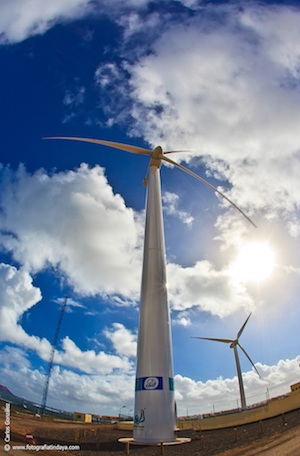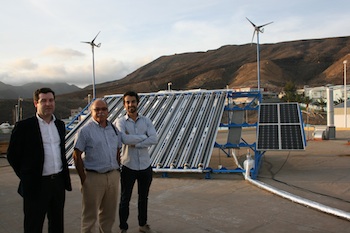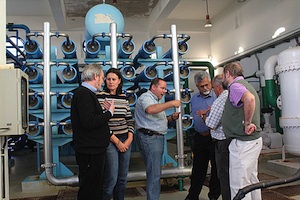A model for islands and dry coastal areas
The entire island of Fuerteventura was declared a biosphere reserve in 2009. It is the most ancient of the Canary Islands, the most arid, and the closest to the African coast. It has a surface area of 1659 square kilometres, a population of 106,456 Einwohner, and attracts 1.6 million tourists each year.
Water and energy are the key factors for the survival of the island and the maintenance of tourism as the main driver of the economy. Dependence on fossil energy has so far been absolute, representing an inadmissible risk for the future of the island.
Seit seiner Ernennung zum Biosphärenreservat, the island of Fuerteventura set water self-sufficiency combined with renewable energy sources as a target to be achieved by 2020. Three action lines converge towards the objective of energy and water self-sufficiency from renewable energy sources.
The wind energy – water desalination binomial
Derzeit natürliche Oberflächen-und Grundwasser-Ressourcen der Insel sind gerade genug, um eine bloße Deckung 10% der Nachfrage, der Rest wird aus Meerwasser gewonnen oder Brackwasserentsalzung.
Partnership between wind farms and desalination plants has been the solution to reduce water dependence. The most important demonstration project has been carried out at Corralejo, in the north of the island. The project consists of a 1.7 MW wind farm for self consumption associated with a sea water desalination plant with a capacity to produce 4000 m3 of water per day. In 2012, the wind farm was able to supply 87.42% of the energy consumption of the desalination plant which supplies the whole tourist area of the north of the island, as well as nearby towns.
The first phase of the Corralejo Renewable Water project has fully demonstrated its technological and economic feasibility. Data obtained from the operation of the plants at Corralejo indicate payback periods not exceeding seven years, trotz der aktuellen finanziellen Situation.
The public water company was also the promoter of the 10.7 MW wind farm of Cañada del Rio in the south of the island, built in 1994 and that is now being increased to 24 MW. Being them the owners of 60% of the wind farm, water price support has been possible in the last years, favouring social water consumption by reducing costs in the main desalination plant of the island.
Biokraftstoffe, water re-use, and fight against desertification
Die erneuerbaren Wasserressourcen Strategie verbindet den Wasserkreislauf mit der Produktion von Biokraftstoffen. The University of La Laguna is in fact successfully developing a pilot project aiming at biofuels production in arid areas from Jatropha curcas seeds in the experimental farm of the Cabildo of Fuerteventura. Das Projekt wird von der Firma Disa Renovables finanziert. A great advantage of this project is the use of non-conventional water resources, such as desalinated water surplus and treated wastewater, for irrigation.
Preliminary results available on oil and biodiesel quality from Fuerteventura crops are really promising. This initiative is also being developed in the framework of the biosphere reserve’s actions related to the fight against desertification, taking advantage of this crop’s ability to fix soil against erosion, on an island classified of high risk. This is also a project where knowledge is transferred from the University to the productive sector, and that promotes public-private partnership, both being important aspects of the National Innovation Strategy and of the Fuerteventura Biosphere Reserve Action Plan.
Solar Ice for the fishermen
Energy consumption to maintain the fish cold for storage and distribution is a relevant part of fishermen communities’ cost structure. Fisheries located in coastal or island areas they have to rely on electricity and fresh water for their ice production process. Mangel an einem oder beiden ist durchaus üblich.
The pilot project carried out at Morro Jable, in the south of Fuerteventura, uses a well known set of technologies (Absorptionskältemaschine, Solarthermie, Photovoltaik, and wind energy) auf grün die Fischerei Business: Verbesserung der Leistung und senken gleichzeitig die Umweltauswirkungen. Außerdem, it improves water efficiency by innovating in the production of ice from sea water instead of fresh water, das ist in ariden Gebieten wie Fuerteventura entscheidende.
Canada
Fuerteventura Renewable Water Project has a significant potential for replication in other thirsty island territories or isolated coastal areas, especially in presence of some tourist development. Through Africagua, a RENFORUS-associated forum, the Fuerteventura model attempts to replicate on other islands such as Principe, Cape Verde, or in the African coast of Mauritania.


















